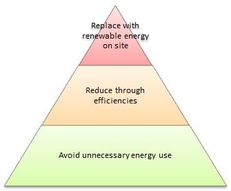SORTED Guide to Sustainability in Further Education – Part 5 - Estates and Operations – 5.2 Estates and Operations: energy and water
Introduction to the topic area
Reducing energy and water consumption is a key area of focus to running efficient buildings. Using the energy efficiency hierarchy, low cost opportunities to reduce unnecessary consumption should be made before investing in more efficient equipment, with renewable energy a consideration once these are in place. It may be however, that opportunities for more efficient equipment and to install renewable energy may come through refurbishment work, new build, or new training development possibilities.
Organisational value of embedding sustainability in this area
- Large costs savings that can be achieved from reducing energy and water consumption. Every penny saved goes straight onto the ‘bottom line’.
- Improved appearance and comfort of buildings – upgrading lighting in particular improves the appearance of buildings, with the additional benefit of large energy savings; increased heating controls allows greater comfort for occupants.
- Installing energy and water saving equipment, and renewable technologies on site offers additional teaching opportunities. Having access to up to date equipment gives students greater advantages when moving onto employment.
- Demonstrating leadership and innovation in this area – to students, staff, local businesses and partners.
- Ensuring legal compliance:
Buildings accessed by the public over 250m2 must display a Display Energy Certificate. These are produced using energy data for each building.
Organisations that use more than 6,000MWh electricity per year and have at least one half-hourly meter settled on the half-hourly electricity market must also adhere to the CRC Energy Efficiency Scheme, a mandatory carbon emissions reporting and pricing scheme.
Wider benefits of embedding sustainability in this area
Reducing energy consumption contributes to national and international carbon reduction targets. In the UK, the Climate Change Act established a target to reduce the UK emissions by at least 80% from 1990 levels by 2050. Ensuring greater resilience of energy and water supply.
Getting started
- Measure your energy and water use – using information on invoices and readings from any sub-meters you have, aim to gather at least 12 months’ data to understand what your buildings are consuming and when.
- Understand where it is being used, and identify your opportunities for making savings – have a walk around to see where energy and water can be saved. Include doing this out of hours to identify wastage (particularly listening out for water flowing when no one is using it). Look at lighting, heating, ventilation, water use, office equipment and building fabric. Read through the Carbon Trust Energy Survey guide for energy saving opportunities to look out for: Prioritise your actions – are there some that are easy to achieve with minimum effort? For example, timer clocks or temperature controls that can be adjusted, or instructions left on display for people to switch off lighting when they leave an area.
- Get leadership support. Prepare business cases for savings that require an initial investment, or extra resource. Ask contractors for quotes, they can also often advise on suggested energy savings that can be achieved. Present your business case to the Finance Director, including installation, running and maintenance costs, compared against present running and maintenance costs. Present the payback (number of years to pay back outlay), as well as any additional benefits, e.g. improvement in controllability, comfort levels, activity appropriate lighting, reliability, etc).
- Feedback to senior management, staff and students on energy and money saved – this will encourage continued efforts to be made, and further initiatives to be supported.
- Join the EAUC Energy & Water Community of Practice and in Scotland, join the EAUC Energy Management Topic Support Network.






 Except where otherwise stated, content on this site is
licensed under a Creative Commons Attribution 3.0 License.
Except where otherwise stated, content on this site is
licensed under a Creative Commons Attribution 3.0 License.
